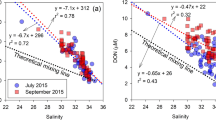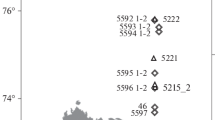Abstract
The changes in the concentrations of dissolved organic carbon and nitrogen (Corg and Norg) in the waters of the western part of the Bering Sea and Anadyr Bay over the last two decades are analyzed. It is shown that Corg and Norg concentrations varied within very wide ranges over all the years of observations. The maximum variability of Corg concentrations (85–481 μM) was observed in the summer months of the 1990s. The variability of these values remained quite wide (66–337 μM) in the autumn of 2012, with a decrease in limiting values and average concentration of Corg. The maximum concentrations were characteristic for the photic layer. The average Norg concentrations were 1.5–2 times less than those in autumn. These facts determined 3–4-fold increase in values for the C : N molar ratio in the dissolved organic matter in summer over autumn. Similar data were also obtained for Anadyr Bay. The revealed primary difference in the amount and elemental composition of dissolved organic matter were caused by seasonal rather than by interannual variations in the conditions of shelf and pelagic ecosystems of the surveyed region.
Similar content being viewed by others
References
A. I. Agatova and N. M. Lapina, “Rate of organic matter transformation and regeneration of biogenic elements in the Bering Sea, in Complex Studies of the Bering Sea Ecosystem, Ed. by B. N. Kotenev and V. V. Sapozhnikov (VNIRO, Moscow, 1995), pp. 226–241.
A. I. Agatova, V. V. Sapozhnikov, and N. I. Torgunova, “Comparative determination of dissolved organic matter by photooxidation with persulfate and high-temperature catalytic burning in various seas,” Okeanologiya (Moscow) 36 (3), 470–477 (1996).
N. A. Arzhanova, V. L. Zubarevich, and V. V. Sapozhnikov, “Seasonal changes in reserves of biogenic elements in euphotic layer and analysis of primary production in the Bering Sea,” in Complex Studies of the Bering Sea Ecosystem, Ed. by B. N. Kotenev and V. V. Sapozhnikov (VNIRO, Moscow, 1995), pp. 162–179.
A. V. Buslov, “Alaska pollack off the eastern coast of Kamchatka: modern reserves and recommendations on rational use,” Izv. Tikhookean. Nauchno-Issled. Inst. Rybn. Khoz. Okeanogr. 152, 3–17 (2008).
A. V. Verkhunov, R. K. Rid, Yu. Yu. Tkachenko, et al., “Large-scale changes of circulation in the Bering Sea (according to expeditions of 1990–1992),” in Complex Studies of the Bering Sea Ecosystem, Ed. by B. N. Kotenev and V. V. Sapozhnikov (VNIRO, Moscow, 1995), pp. 39–52.
K. K. Kivva and D. N. Chul’chekov, “Oceanological surveys in the western part of the Bering Sea,” Oceanology (Engl. Transl.) 54 (4), 541–543 (2014).
B. N. Kotenev, “Water dynamics as an important factor of the long-term variability of biological productivity of waters and reproduction of fish reserves in the Bering Sea,” in Complex Studies of the Bering Sea Ecosystem, Ed. by B. N. Kotenev and V. V. Sapozhnikov (VNIRO, Moscow, 1995), pp. 7–38.
N. V. Mordasova, M. P. Metreveli, and M. V. Venttsel’, “Pigments of phytoplankton in western part of the Bering Sea,” in Complex Studies of the Bering Sea Ecosystem, Ed. by B. N. Kotenev and V. V. Sapozhnikov (VNIRO, Moscow, 1995), pp. 256–264.
E. I. Musaeva and E. G. Kolosova, “Distribution of zooplankton in the Bering Sea,” in Complex Studies of the Bering Sea Ecosystem, Ed. by B. N. Kotenev and V. V. Sapozhnikov (VNIRO, Moscow, 1995), pp. 318–329.
Yu. I. Sorokin, “Primary production in the Bering Sea,” in Complex Studies of the Bering Sea Ecosystem, Ed. by B. N. Kotenev and V. V. Sapozhnikov (VNIRO, Moscow, 1995), pp. 264–276.
Handook of Hydrochemist. Fish Farming (Agropromizdat, Moscow, 1991), pp. 87–89.
V. P. Shuntov, Biology of Far Eastern Seas of Russia (TINRO-Tsentr, Vladivostok, 2001), Vol. 1.
A. I. Agatova, N. A. Arzhanova, and N. I. Torgunova, “Organic matter of the Bering Sea,” in Dynamics of the Bering Sea, Ed. by T. R. Loughlin, et al. (Alaska Sea Grant College Program, Fairbanks, 1999), pp. 261–284.
K. Banse, “New views on the degradation of organic particles as collected by sediment traps in the open sea,” Deep-Sea Res., No. 37, 1177–1195 (1990).
Z. W. Brown and K. R. Arrigo, “Sea ice impacts on spring bloom dynamics and net primary production in the Eastern Bering Sea,” J. Geophys. Res.: Oceans 118, 43–62 (2013).
C. A. Carlson, “Production and removal processes,” in Biogeochemistry of Marine Dissolved Organic Matter, Ed. by D. A. Hansell, et al. (Academic, San Diego, 2002), pp. 91–151.
B. C. Cho and F. Azam, “Major role of bacteria in biogeochemical fluxes in the ocean’s interior,” Nature, No. 332, 441–443 (1988).
L. W. Cooper, M. A. Janout, K. E. Frey, et al., “The relationship between sea ice break-up, water mass variation, chlorophyll biomass, and sedimentation in the northern Bering Sea,” Deep-Sea Res., Part II 65–70, 141–162 (2012).
J. N. Cross, J. T. Mathis, and N. R. Bates, “Hydrographic controls on net community production and total organic carbon distributions in the eastern Bering Sea,” Deep-Sea Res., Part II 65–70, 98–109 (2012).
L. Guo, T. Tanaka, D. Wang, et al., “Distributions, speciation and stable isotope composition of organic matter in the southeastern Bering Sea,” Mar. Chem. 91, 211–226 (2004).
N. Handa and E. Tanoue, “Organic matter in the Bering Sea and adjacent areas,” in The Eastern Bering Sea Shelf: Oceanography and Resources (University of Washington Press, Washington, 1979), pp. 359–381.
G. L. Hunt, K. O. Coyle, L. B. Eisner, et al., “Climate impacts on eastern Bering Sea foodwebs: a synthesis of new data and an assessment of the Oscillating Control Hypothesis,” ICES J. Mar. Sci. 68, 1230–1243 (2011).
A. Kortzinger, W. Koeve, P. Kahler, et al., “C: N ratios in the mixed layer during the productive season in the northeast Atlantic Ocean,” Deep-Sea Res., Part I 48, 661–688 (2001).
M. W. Lomas, S. B. Moran, J. R. Casey, et al., “Spatial and seasonal variability of primary production on the Eastern Bering Sea shelf,” Deep-Sea Res., Part II 65–70, 126–140 (2012).
J. R. Lovvorn, L. W. Cooper, M. L. Brooks, et al., “Organic matter pathways to zooplankton and benthos under pack ice in late winter and open water in late summer in the north-central Bering Sea,” Mar. Ecol.: Progr. Ser. 291, 135–150 (2005).
J. H. Sharp, K. R. Rinker, K. B. Savidge, et al., “A preliminary methods comparison for measurement of dissolved organic nitrogen in seawater,” Mar. Chem. 78, 171–184 (2002).
P. J. Stabeno, J. D. Schumacher, and K. Ohtani, “The physical oceanography of the Bering Sea,” in Dynamics of the Bering Sea, Ed. by T. R. Loughlin, et al. (Alaska Sea Grant College Program, Fairbanks, 1999), pp. 1–28.
Y. Sugimura and Y. Suzuki, “A high temperature catalytic oxidation method of non-volatile dissolved organic in seawater by direct injection of liquid samples,” Mar. Chem., No. 20, 113–119 (1988).
Y. Suzuki, T. Sugimura, and T. Itoh, “A catalytic oxidation method for the determination of total nitrogen dissolved in seawater,” Mar. Chem., No. 16, 83–97 (1985).
A. V. Tsyban, “The BERPAC project: development and overview of ecological investigations in the Bering and Chukchi Seas,” in Dynamics of the Bering Sea, Ed. by T. R. Loughlin, et al. (Alaska Sea Grant College Program, Fairbanks, 1999), pp. 713–732.
J. J. Walsh and C. P. McRoy, “Ecosystem analysis in the southeastern Bering Sea,” Cont. Shelf Res., No. 5, 259–288 (1986).
Author information
Authors and Affiliations
Corresponding author
Rights and permissions
About this article
Cite this article
Agatova, A.I., Kivva, K.K. & Torgunova, N.I. Spatiotemporal variability of organic matter in the waters of the Bering Sea. Oceanology 55, 182–193 (2015). https://doi.org/10.1134/S0001437015020010
Received:
Published:
Issue Date:
DOI: https://doi.org/10.1134/S0001437015020010




